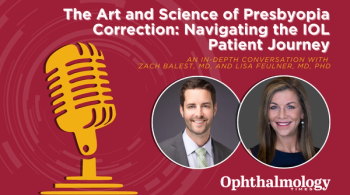
Can retinal ganglion cellular dysfunction reverse itself by IOP decrease after trabeculectomy?
Ganglion cellular dysfunction may reverse itself as the result of a substantial decrease in IOP after trabeculectomy in patients with glaucoma, according to John Mark S. de Leon, MD.
Los Angeles-Ganglion cellular dysfunction may reverse itself as the result of a substantial decrease in
This finding was based on a study in which Dr. de Leon and colleagues investigated the changes in the visual field threshold sensitivity in the fast and slow components of visual field decay in patients after trabeculectomy.
The investigators retrospectively reviewed the visual fields of patients with open-angle glaucoma who had undergone trabeculectomy, explained Dr. de Leon, a research fellow in ophthalmology, Jules Stein Eye Institute, University of California, Los Angeles. Four or more reliable preoperative and postoperative visual field tests were available for all eyes. Patients were included in the study when the last preoperative and first postoperative visual field tests were obtained within 1.5 years of the surgery and when the patients were followed preoperatively and postoperatively for a minimum of 2 years.
Every visual field location was assigned to either fast or slow decay components based on point-wise exponential regression and the decay curves were fit to the sensitivities of the preoperative and postoperative visual field measurements separately. The sensitivity difference between the first postoperative and the last preoperative visual field value at each test location was estimated by the exponential curve fits.
The visual field mean deviation (MD) also was fit for the preoperative and postoperative visual fields using linear regression, Dr. de Leon said.
He reported that 71 eyes of 65 patients were followed for an average of 11.9 ± 2.9 years (5.5 ± 2.4 years preoperatively and 5.5 ± 2.4 years postoperatively) and an average of 20.2 ± 8.1 visual fields (10.7 ± 5.9 preoperative visual fields and 9.5 ± 4.7 postoperative visual fields) were obtained.
Postoperatively, investigators observed that the average sensitivity of the fast component locations significantly (p < 0.0001) increased from 20.4 ± 6.1 dB to 22.1 ± 5.4 dB, and the slow component locations significantly (p = 0.004) decreased from 24.7 ± 3.7 dB to 23.9 ± 4.1 dB. For the former, the sensitivity improved (1.74 ± 2.2 dB) but deteriorated (-0.79 ± 2.2 dB) for the latter (p < 0.0001). The average preoperative MD did not differ significantly (p = 0.12) postoperatively (-8.4 ± 5.3 and -9 ± 6.6, respectively).
The investigators observed significant differential effects on the fast and slow components of visual field decay. The sensitivity of the slow component decreased slightly, which was consistent with progressive cataract. In contrast, the sensitivity of the fast visual field component increased significantly, suggesting that retinal ganglion cellular damage may reverse itself after a substantial decrease in IOP, and this may happen more often than considered previously, Dr. de Leon said.
The MD is not sufficiently sensitive to detect such changes in visual field sensitivity, he added.
Newsletter
Don’t miss out—get Ophthalmology Times updates on the latest clinical advancements and expert interviews, straight to your inbox.


















































.png)


